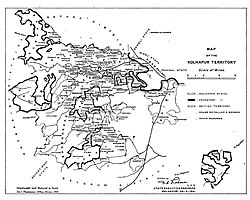
Back Kolhapur Catalan Kolhapur (Staat) German État de Kolhapur French कोल्हापुर रियासत Hindi Kolhapur (stato) Italian コールハープル・マラーター王国 Japanese कोल्हापूर संस्थान Marathi ریاست کولہاپور PNB Колхапур (княжество) Russian கோல்ஹாப்பூர் அரசு Tamil
State of Kolhapur | |||||||||
|---|---|---|---|---|---|---|---|---|---|
| 1710–1949 | |||||||||
 Kolhapur State Map, 1912 | |||||||||
| Status | Principality within the Maratha Confederacy (1707–1818) Protectorate of the East India Company (1818–1857) Princely State of the India (1857–1947) State of the Dominion of India (1947–1949) | ||||||||
| Capital | Kolhapur | ||||||||
| Raja/Maharaja | |||||||||
• 1710–1714 (first) | Shivaji I | ||||||||
• 1947–1949 (last) | Shahaji II | ||||||||
| History | |||||||||
• Established | 1710 | ||||||||
• Acceded to Dominion of India | 1947 | ||||||||
• Merged into Bombay State | 1949 | ||||||||
| Area | |||||||||
| 1901 | 8,332 km2 (3,217 sq mi) | ||||||||
| Population | |||||||||
• 1901 | 910,011 | ||||||||
| |||||||||
| Today part of | Maharashtra, India | ||||||||
The Kolhapur State was a Maratha princely state of India, under the Deccan Division of the Bombay Presidency, and later the Deccan States Agency.[1] It was considered the most important of the Maratha principalities[citation needed] with the others being Baroda State, Gwalior State and Indore State. Its rulers, of the Bhonsle dynasty, were entitled to a 19-gun salute – thus Kolhapur was also known as a 19-gun state. The state flag was a swallow-tailed saffron pennant.[2]

Kolhapur State, together with its jagirs or feudatory vassal estates (including Ichalkaranji), covered an area of 3,165 square miles (8,200 km2).[3] According to the 1901 census, the state population was 910,011, of which 54,373 resided in Kolhapur Town. In 1901, the state enjoyed an estimated revenue of £300,000.[3][4]
- ^ "Kolhapur State". The Imperial Gazetteer of India, Vol. 15. Oxford at Clarendon Press. 1909. pp. 380–87.
- ^ Gazetteer, p. 380
- ^ a b Chisholm, Hugh, ed. (1911). . Encyclopædia Britannica. Vol. 15 (11th ed.). Cambridge University Press. p. 889.
- ^ "Kolhapur Princely State (19 gun salute)". Archived from the original on 4 March 2016. Retrieved 30 June 2014.

